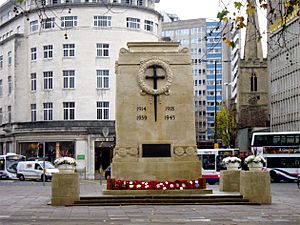Bristol Cenotaph facts for kids
The Bristol Cenotaph is a special war memorial found in Magpie Park, in Bristol. It was built in 1932 to remember the brave people from Bristol who lost their lives fighting in wars. This important monument is also a Grade II listed building, meaning it's protected because of its historical value. It was designed by a local architect named Eveline Blacker and her partner Harry Heathman.
Contents
Remembering Bristol's Heroes
During the First World War, about 60,000 men from Bristol joined the British armed forces. Sadly, around 4,500 of them were killed. After the war ended, the city of Bristol wanted to build a memorial to honor these heroes.
Deciding on a Memorial
It took many years to decide what kind of memorial to build. Some people wanted a simple structure just for remembering. Others preferred a more practical project, like a special hospital. It was hard to raise enough money for a big project. In the end, the committee decided on a commemorative structure.
Where to Put the Memorial
Choosing the right place for the memorial was also a big discussion. Many spots were suggested, like near Bristol Cathedral or in The Downs. Finally, a place at the north end of Colston Avenue was chosen. This area was built over the River Frome in the 1890s.
Designing the Cenotaph
The public helped raise £1,700 for the memorial. Local architects were asked to submit their designs. A committee picked the top three designs from 18 entries. All three were inspired by the famous Cenotaph in Whitehall, London.
The winning design came from the firm of Harry Heathman and Eveline Blacker. It was chosen over designs by Charles Roy Beechcroft and Adrian E. Powell. It was quite unusual for a woman to design such a major public monument at that time.
What the Cenotaph Looks Like
The Bristol Cenotaph is a rectangular stone monument, about 6 meters (20 feet) tall. It is made from a type of stone called shelly limestone. On top, there is a stone coffin-like shape called a sarcophagus. Bundles of spears are carved on either side.
The Base and Details
The main stone stands on a plinth, which is a sturdy base, with steps leading up to it. At each corner of the base, there are four stone pillars, each with a bronze lion's head. Outside the base, there are four bronze lamp standards.
Important Inscriptions and Symbols
The longer sides of the memorial face north and south. Each side has a carved stone wreath and a bronze sword. The sword was originally shiny gold. The dates "1914" and "1939" are on the left, and "1918" and "1945" are on the right. These dates mark the start and end of the First World War and the Second World War.
There are also carved stone medallions showing the arms (symbols) of the city of Bristol, the British Army, the Royal Navy, and the Royal Air Force. A large bronze plaque in the center has a special message.
Messages of Remembrance
The plaque on the north side says: SACRED TO THE MEMORY / OF BRISTOL'S SONS AND / DAUGHTERS, WHO MADE / THE SUPREME SACRIFICE Below this, in smaller letters, it reads: "THEY DIED THAT MANKIND MIGHT LEARN TO LIVE IN PEACE".
The plaque on the south side has the first and third verses from a hymn called "O Valiant Hearts". It reads: O VALIANT HEARTS WHO TO YOUR GLORY CAME THROUGH DUST OF CONFLICT AND THROUGH BATTLE FLAME: TRANQUIL YOU LIE, YOUR KNIGHTLY VIRTUE PROVED, YOUR MEMORY HALLOWED IN THE LAND YOU LOVED: SPLENDID YOU PASSED THE GREAT SURRENDER MADE INTO THE LIGHT THAT NEVERMORE SHALL FADE. ALL YOU HAD HOPED FOR, ALL YOU HAD, YOU GAVE TO SAVE MANKIND, YOURSELVES YOU SCORNED TO SAVE This side also has two torches, turned upside down.
The shorter sides, facing east and west, are simpler. They each have two medallions carved with flower emblems, one for England, Scotland, Ireland, and Wales. There is also a bronze symbol of Bristol's city arms.
Unveiling and Recognition
The Bristol Cenotaph was officially revealed on July 26, 1932, by Field Marshal Sir William Birdwood. The dates "1939" and "1945" were added later to remember those who died in the Second World War. In 1977, it became a Grade II listed building, recognizing its importance.


